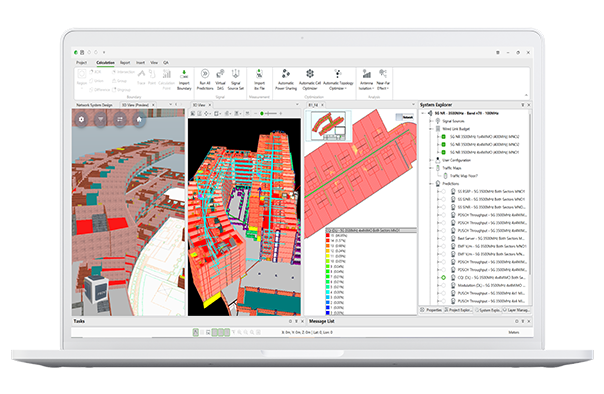Wi-Fi 7 vs. Private Wireless Networks: A Comprehensive Comparison

As wireless technologies continue to evolve, the introduction of Wi-Fi 7 and the growing adoption of private wireless networks present new possibilities for businesses and consumers alike. Both technologies promise faster speeds, lower latency, and more reliable connections, but they serve different purposes and offer unique benefits. In this blog, we’ll explore the key differences between Wi-Fi 7 and private wireless networks, helping you plan the right fit for your needs.
What is Wi-Fi 7?
Wi-Fi 7, also known as IEEE 802.11be, is the next generation of Wi-Fi technology, expected to deliver significant improvements over its predecessor, Wi-Fi 6. While Wi-Fi 6 introduced better bandwidth management and efficiency, Wi-Fi 7 aims to push the boundaries even further with enhanced features such as:
- Multi-Link Operation (MLO): Wi-Fi 7 can simultaneously connect to multiple bands (2.4 GHz, 5 GHz, and 6 GHz), improving throughput and reducing latency.
- 320 MHz Channels: This wider channel width doubles the 160 MHz channels of Wi-Fi 6, allowing for higher data rates.
- 4K QAM (Quadrature Amplitude Modulation): Higher modulation rates enable faster data transmission, further boosting the overall speed.
- Target Wake Time (TWT): Optimizes power consumption for IoT devices, prolonging battery life.
With speeds potentially reaching up to 46 Gbps, Wi-Fi 7 is ideal for applications requiring ultra-high throughput, such as 8K video streaming, virtual reality (VR), and large-scale file transfers.
What are Private Wireless Networks?
Private Wireless Networks, often referred to as private LTE or private 5G, are dedicated cellular networks designed to offer secure, reliable, and high-performance wireless connectivity within a specific area, such as a factory, campus, or enterprise environment. These networks are tailored to meet the specific needs of an organization, offering:
- Customization: Private wireless networks can be optimized for specific use cases, such as low latency for industrial automation or high capacity for large venues.
- Enhanced Security: With a dedicated network, organizations have full control over security protocols, reducing the risk of interference or unauthorized access.
- Dedicated Spectrum: Unlike Wi-Fi, which operates in unlicensed spectrum, private wireless networks often use licensed spectrum, providing more consistent performance and less interference.
- Scalability: These networks are designed to handle a large number of connected devices, making them ideal for IoT deployments and smart infrastructure.
Private wireless networks are particularly beneficial for industries like manufacturing, healthcare, and logistics, where reliability, security, and control are paramount.
Key Differences
1. Use Case and Application:
- Wi-Fi 7: Primarily consumer-focused, Wi-Fi 7 is well-suited for home networks, offices, and public hotspots. It's designed to handle high-density environments, such as stadiums or conference centres, with a large number of devices needing high-speed internet access.
- Private Wireless Networks: These are enterprise-grade solutions, ideal for specific industrial applications requiring ultra-reliable low latency communication (URLLC), massive machine type communication (mMTC) for IoT connectivity, or enhanced mobile broadband (eMBB) in controlled environments.
2. Spectrum:
- Wi-Fi 7: Operates in unlicensed spectrum, which is more prone to interference but widely accessible.
- Private Wireless Networks: Typically use licensed spectrum, providing more predictable performance and less interference, though at a higher cost.
3. Security:
- Wi-Fi 7: While Wi-Fi 7 introduces improvements in security protocols, it still relies on a shared medium, making it more vulnerable to certain types of attacks.
- Private Wireless Networks: Offer more robust security through dedicated infrastructure and spectrum, allowing organizations to implement customized security measures.
4. Performance:
- Wi-Fi 7: Promises significant speed and efficiency improvements, but performance can still vary based on network congestion and interference.
- Private Wireless Networks: Provide consistent, high-performance connectivity, especially in environments where interference is a concern or where strict performance guarantees are required.
5. Cost:
- Wi-Fi 7: Generally, Wi-Fi 7 networks are more cost-effective to deploy, especially in consumer or small business settings.
- Private Wireless Networks: Require a larger investment in infrastructure, spectrum licensing, and ongoing management, making them more suitable for large enterprises or specific industrial applications.
Planning Wi-Fi 7 and Private Wireless Networks with Ranplan Professional
Effective network planning is crucial for optimizing the performance of both Wi-Fi 7 and Private Wireless Networks, and Ranplan Professional is an indispensable tool in this process. This software allows engineers to meticulously plan, simulate, and deploy both types of networks with precision. Ranplan Professional offers a comprehensive suite of features tailored for modern wireless environments, including multi-layer building structures, outdoor-indoor connectivity, and high-density areas. With Ranplan Professional, you can model the advanced characteristics of Wi-Fi 7, or design Private Wireless Networks that meet stringent requirements for latency, reliability, coverage, and capacity. The software’s detailed simulation capabilities enable engineers to identify potential issues, optimize the placement of access points and small cells in the orders of hundreds or thousands, and ensure that the network design aligns with both technical and operational goals, resulting in a typical 20-30% CAPEX and OPEX savings. Whether deploying a cutting-edge Wi-Fi 7 network in a public venue or a private LTE/5G network in an industrial facility, Ranplan Professional provides the accuracy and flexibility needed to achieve optimal network performance.
Conclusion
Wi-Fi 7 and private wireless networks represent the forefront of wireless technology, each offering unique strengths that cater to different needs. Wi-Fi 7 delivers unprecedented speeds and efficiency for general consumer and enterprise environments, while private wireless networks provide a customized, secure, and high-performance solution for specific industrial applications. By understanding the distinct advantages of each technology and utilizing tools like Ranplan Professional for meticulous network planning, you can make informed decisions and fully leverage the capabilities of these advanced wireless solutions.
Author:

Discover how to design and optimize advanced communication networks for large enterprise buildings with Ranplan Professional



